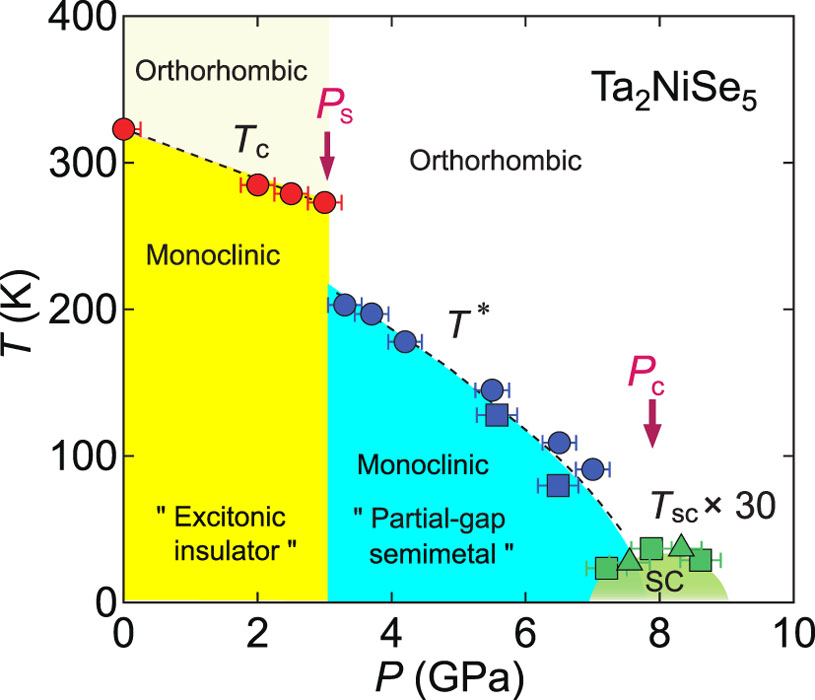Pressure-Induced Superconductivity in the Excitonic Insulator Candidate Ta2NiSe5
Uwatoko Group
Superconductor hosts a condensate of electron pairs (Cooper pairs), which can conduct electricity without any loss of energy. In conventional superconductivity, an attractive interaction mediated by lattice vibrations can lead electrons to form pairs. The bound states through attractive Coulomb attraction between electrons and holes, similar to Cooper pairs in superconductivity, are called excitons. A spontaneous condensation of excitons with lowering temperature is expected to occur due to weakly screened Coulomb interactions in narrow gap semiconductors and semimetals. In that case, the system becomes an insulator known as an excitonic insulator. The excitonic insulator was theoretically proposed more than 50 years ago, however, experimental facts for excitonic state are far from conclusive.
A layered chalcogenide Ta2NiSe5 located near the semiconductor-semimetal boundary has in recent years attracted attention as a promising candidate for the excitonic insulator. At ambient pressure, semiconductor-to-insulator transition occurs at Tc ~ 328 K, accompanied with a structural phase transition from high-temperature orthorhombic to low-temperature monoclinic. The transition at Tc has been discussed to be the excitonic transition as manifested by the characteristic flattening of the valence band [1]. Furthermore, the control of energy gap using a solid-solution Ta2Ni(Se1−xSx)5 and an application of moderate pressure reproduce the canonical phase diagram for the excitonic insulator [2]. Here we show a high-pressure phase diagram of Ta2NiSe5 covering the whole range from semiconducting to semimetallic region for the first time, and discovered pressure-induced superconductivity in the semimetallic phase [3].
Figure 1 depicts a pressure-temperature phase diagram of Ta2NiSe5 based on bulk measurements under pressure. Ta2NiSe5 exhibits a first-order structural transition under pressure at Ps ~ 3 GPa, which is accompanied by the change from an almost zero-gap semiconductor to a semimetal. In the pressure-induced semimetallic phase, there appears a transition to another semimetal with a partial-gap at T*, accompanied with a lattice distortion analogous to that occurs at the excitonic transition at low-pressure semiconducting phase. With increasing pressure, T* is suppressed and reaches to zero temperature around Pc ~ 8 GPa. A dome-like superconducting phase with a maximum Tsc ~ 1.2 K emerges around Pc. Since the Coulomb interactions between electrons and holes should be screened out substantially due to the increased carrier density, applying pressure changes the character of the gap from excitonic dominant to hybridization gap dominant on increasing the band overlap. Our results evidence the presence of the electron-lattice coupling may be one of the key ingredients for the occurrence of superconductivity and the excitonic transition in the low-pressure phase.
References
- [1]Y. Wakisaka, T. Sudayama, K. Takubo, T. Mizokawa, M. Arita, H. Namatame, M. Taniguchi, N. Katayama, M. Nohara, and H. Takagi, Phys. Rev. Lett. 103, 026402 (2009).
- [2]Y. F. Lu, H. Kono, T. I. Larkin, A. W. Rost, T. Takayama, A. V. Boris, B. Keimer, and H. Takagi, Nat. Commun. 8, 14408 (2017).
- [3]K. Matsubayashi, H. Okamura, T. Mizokawa, N. Katayama, A. Nakano, H. Sawa, T. Kaneko, T. Toriyama, T. Konishi, Y. Ohta, H. Arima, R. Yamanaka, A. Hisada, T. Okada, Y. Ikemoto, T. Moriwaki, K. Munakata, A. Nakao, M. Nohara, Y. Lu, H. Takagi, and Y. Uwatoko, J. Phys. Soc. Jpn. 90, 074706 (2021).

